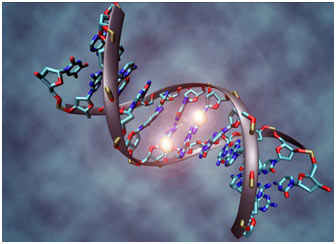Definition
Deoxyribonucleic acid is a molecule composed of two polynucleotide chains that coil around each other to form a double helix carrying hereditary instructions for the development, functioning, growth, and reproduction of all types of lives and lots of viruses.
DNA Structure
DNA is a long, thread-like macromolecule comprised of a large number of deoxyribonucleotides. Deoxyribonucleotide is made up of a nitrogenous base, a sugar, and a phosphate group. The bases of DNA particle carry hereditary info, whereas their sugar and phosphate groups carry out a structural role. The sugar in a deoxyribonucleotide is deoxyribose.
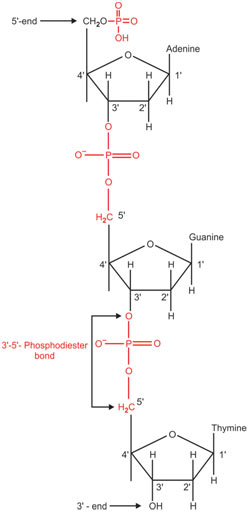
The purine bases in DNA are adenine (A), and guanine (G). Pyrimidine bases are thymine (T) and cytosine (C). DNA is a polymer of many deoxyribonucleotides connected covalently by 3′, 5′ phosphodiester bonds. The 3′- hydroxyl group of the sugar moiety of one deoxyribonucleotide is joined to the 5′- hydroxyl group of the surrounding sugar moiety of deoxyribonucleotide by a phosphodiester linkage.
The Watson-Crick DNA Double Helical Structure
In 1953, James Watson and Francis Crick deduced the three-dimensional structure of DNA. The essential functions of their model of DNA are as follows:
Two helical polynucleotide chains are coiled around a common axis. The chains run in opposite directions (anti-parallel). The purine and pyrimidine bases are on the inside of the helix, whereas the phosphate and deoxyribose units are on the outside. The diameter of the helix is 20 Å. Surrounding bases are separated by 3.4 Å along the helix axis and the helical structure repeats after ten residues on each chain, i.e. at intervals of 34 Å.
The two chains are held together by hydrogen bonds in between complementary pairs of bases:
Adenine is constantly paired with thymine by the formation of two hydrogen bonds. Guanine is always paired with cytosine by the development of three hydrogen bonds.
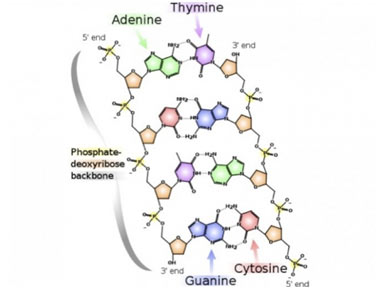
The two strands are always complementary to each other. In a double-stranded DNA molecule, the material of adenine equals to that of thymine, and the contents of guanine equal to that of cytosine. The complementary base pairing proves Chargaff’s rule.
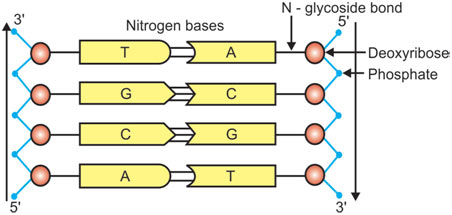
The model proposed by Watson and Crick is a B type of DNA (B-DNA) which is a best-handed helix of 10 base pairs per turn, containing grooves of alternate size, known as significant and small grooves.
Other kinds of DNA might likewise occur, such as A-DNA( It is a right-handed double helix relatively similar to the more common B-DNA kind, however with a shorter, more compact helical structure whose base sets are not perpendicular to the helix-axis as in B-DNA.) and Z-DNA( It is a left-handed double helical structure in which the helix winds to the left in a zigzag pattern, instead of to the right, like the more common B-DNA form.).
Under physiologic conditions, DNA is nearly completely in Watson-Crick B kind.
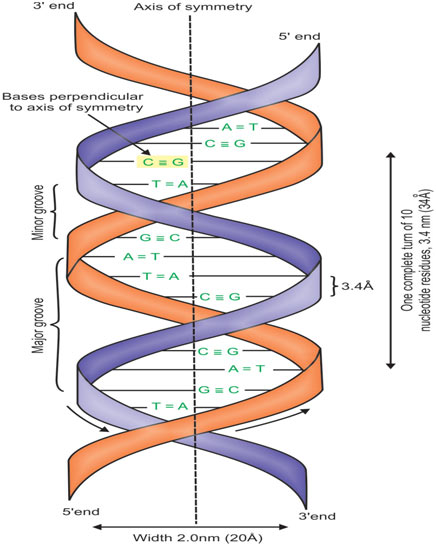
Chargaff’s Rule
Ervin Chargaff discovered that in DNA of all types, the number of purines is the same as that of pyrimidines (A+G= T+C). He observed that in DNA, the content of adenine equals that of thymine (A= T) and the material of guanine equals that of cytosine (G= C). Watson and Crick deduced that adenine should couple with thymine and guanine with cytosine, because of stearic and hydrogen bonding elements.
Adenine can not couple with cytosine; guanine can not pair with thymine. Thus, one member of a base pair in a DNA must constantly be a purine and the other a pyrimidine. This base-pairing constraint discusses that in a double-stranded DNA molecule, the content of A equals that of T and the material of G equals that of C.
| Key!!!!!
[To remember the base pairs here is an interesting key: AT= English preposition at; GC= Government College] |
The ratio of purine to pyrimidine bases in the DNA is constantly one, i.e. G+A: T+C = 1. This is that of Chargaff’s guideline.
Organization of DNA
Prokaryotic DNA
- A prokaryotic cell generally consists of a single chromosome composed of double-stranded circular DNA, which consists of over 4 x 106 base pairs. Since DNA molecules are so large, they need unique organization/packaging to allow them to live within cells. In E. coli, the circular DNA is supercoiled and connected to an RNA-protein core.
Eukaryotic DNA
- Eukaryotes consist of over 1,000 times the amount of DNA discovered in prokaryotes. Consequently, their technique of arranging or packing DNA is far more complex. A normal human cell has 46 chromosomes, whose total DNA is roughly two meter in length. The packing of DNA in a chromosome represents a 10,000-fold shortening of its length from primary B-form DNA. In resting nondividing eukaryotic cells, the chromosomal product is called chromatin. Chromatin is comprised of nucleosomes.
Functions of DNA
DNA is the storehouse of genetic information. The hereditary information saved in the DNA serves two functions.
- It is the source of details for the synthesis of all protein molecules of the cell and
- It provides the information inherited by daughter cells or offspring.
FAQs about DNA
Q1: What is DNA, and why is it essential for living organisms?
A1: DNA, or deoxyribonucleic acid, is a molecule carrying hereditary instructions for the development, functioning, growth, and reproduction of all living organisms. It’s crucial because it holds the genetic code, determining the traits and functions of living things.
Q2: How is DNA structured, and what are its building blocks?
A2: DNA has a double-helix structure formed by two polynucleotide chains. Its building blocks are deoxyribonucleotides, each consisting of a nitrogenous base, a sugar (deoxyribose), and a phosphate group.
Q3: Who proposed the DNA double-helical structure, and what are its key features?
A3: James Watson and Francis Crick proposed the DNA double-helical structure. Key features include anti-parallel chains, purine and pyrimidine bases on the inside, and phosphate/deoxyribose units on the outside.
Q4: What is Chargaff’s Rule, and how does it relate to DNA base pairing?
A4: Chargaff’s Rule states that in DNA, the number of purines equals the number of pyrimidines. Adenine pairs with thymine, forming two hydrogen bonds, and guanine pairs with cytosine, forming three hydrogen bonds.
Q5: Are there different types of DNA structures?
A5: Yes, there are different types, such as B-DNA (right-handed double helix), A-DNA (right-handed, shorter helix), and Z-DNA (left-handed helix). However, B-DNA is the most common under physiological conditions.
Q6: How is DNA organized in prokaryotic and eukaryotic cells?
A6: Prokaryotic cells have a single circular DNA, supercoiled and connected to an RNA-protein core. Eukaryotic cells, with more DNA, organize it into chromosomes during cell division.
Q7: What are the functions of DNA in living organisms?
A7: DNA serves as the source of information for synthesizing proteins in the cell. Additionally, it carries hereditary information inherited by daughter cells or offspring.
Q8: Can DNA be found in places other than the cell nucleus?
A8: Yes, in addition to the nucleus, DNA is present in mitochondria (in small amounts) and plant chloroplasts. Some viruses also use DNA as their genetic material.
Q9: How does DNA packing occur in eukaryotic cells?
A9: Eukaryotic cells pack DNA into chromosomes during cell division. In non-dividing cells, DNA is organized as chromatin, consisting of nucleosomes.
Q10: Are there practical applications of understanding DNA structure and function?
A10: Absolutely! Understanding DNA helps in various fields, including medicine, genetics, and biotechnology. It’s crucial for advancements like genetic engineering and medical treatments.
Multiple Choice Questions (MCQs) with Answers
a) Energy production
b) Protein synthesis
c) Cellular respiration
d) Waste elimination
Answer 1: b) Protein synthesis
Question 2: Where is DNA located in eukaryotic cells?
a) Cytoplasm
b) Nucleus
c) Mitochondria
d) Chloroplasts
Answer 2: b) Nucleus
Question 3: What is a deoxyribonucleotide made up of?
a) Amino acid, sugar, and phosphate
b) Nitrogenous base, sugar, and phosphate
c) Fatty acid, sugar, and phosphate
d) Amino acid, nitrogenous base, and phosphate
Answer 3: b) Nitrogenous base, sugar, and phosphate
Question 4: Who proposed the three-dimensional structure of DNA?
a) Rosalind Franklin
b) Gregor Mendel
c) James Watson and Francis Crick
d) Linus Pauling
Answer 4: c) James Watson and Francis Crick
Question 5: Which type of DNA is the model proposed by Watson and Crick?
a) A-DNA
b) B-DNA
c) Z-DNA
d) C-DNAAnswer 5: b) B-DNA
Question 6: According to Chargaff’s Rule, what is the ratio of purines to pyrimidines in DNA?
a) 2:1
b) 1:1
c) 3:1
d) 1:2Answer 6: b) 1:1
Question 7: How are the two strands of DNA held together in the double helix?
a) Covalent bonds
b) Ionic bonds
c) Hydrogen bonds
d) Van der Waals forces
Answer 7: c) Hydrogen bonds
Question 8: What is the diameter of the DNA helix according to the Watson-Crick model?
a) 10 Å
b) 20 Å
c) 30 Å
d) 40 Å
Answer 8: b) 20 Å
Question 9: Which scientist discovered that the number of purines equals the number of pyrimidines in DNA?
a) James Watson
b) Erwin Chargaff
c) Rosalind Franklin
d) Linus Pauling
Answer 9: b) Erwin Chargaff
Question 10: In Chargaff’s Rule, what does A+G equal?
a) T+C
b) G+C
c) A+T
d) A+T+C+G
Answer 10: a) T+C
Question 11: What is the primary structure of DNA called?
a) A-DNA
b) B-DNA
c) Z-DNA
d) C-DNA
Answer 11: b) B-DNA
Question 12: Where is DNA present in prokaryotic cells?
a) Nucleus
b) Mitochondria
c) Chloroplasts
d) Circular DNA in the cell
Answer 12: d) Circular DNA in the cell
Question 13: What forms a complex known as chromatin in eukaryotic DNA?
a) RNA
b) Proteins
c) Lipids
d) Carbohydrates
Answer 13: b) Proteins
Question 14: What is the function of DNA in cells?
a) Energy storage
b) Information storage and protein synthesis
c) Waste elimination
d) Cellular respiration
Answer 14: b) Information storage and protein synthesis
Question 15: In eukaryotic cells, where is DNA separated from the cytoplasm?
a) Nucleus
b) Mitochondria
c) Chloroplasts
d) Ribosomes
Answer 15: a) Nucleus
Conclusion:
In conclusion, the exploration of DNA structure, function, and the groundbreaking Watson and Crick model, along with Chargaff’s Rule, provides profound insights into the molecular basis of heredity and cellular function. DNA, or deoxyribonucleic acid, serves as the fundamental genetic material for both prokaryotic and eukaryotic cells. The intricate organization of DNA, particularly its location in the nucleus of eukaryotes and the presence in various cellular organelles, underscores its critical role in transmitting genetic information.
The elucidation of the Watson-Crick DNA double helical structure in 1953 revolutionized our understanding of DNA’s physical architecture. This model revealed the anti-parallel coiling of two polynucleotide chains, forming a helical structure with distinct grooves. The complementary base pairing of adenine with thymine and guanine with cytosine, as dictated by Chargaff’s Rule, ensures the fidelity of genetic information transfer.
The B-type DNA proposed by Watson and Crick, with its specific helical parameters and hydrogen bonding, remains a cornerstone in molecular biology. Despite the existence of other DNA conformations like A-DNA and Z-DNA, the prevalent physiological state is the Watson-Crick B form.
The organization of DNA in prokaryotic and eukaryotic cells highlights the adaptability of DNA structures to suit the unique needs of different organisms. Prokaryotic DNA, typically a circular molecule, undergoes supercoiling and associates with an RNA-protein core. In contrast, eukaryotic DNA, with its extensive length, is intricately packed into chromosomes during cell division, a process regulated by chromatin formation.
Ultimately, the functions of DNA extend beyond being a mere repository of genetic information. It serves as the blueprint for the synthesis of all cellular proteins, influencing the development, functioning, growth, and reproduction of living organisms. Moreover, this genetic information is faithfully inherited by daughter cells and offspring, perpetuating the essential characteristics of life.
In unraveling the complexities of DNA, scientists have paved the way for advancements in genetics, molecular biology, and medicine, offering profound implications for our understanding of life itself.

